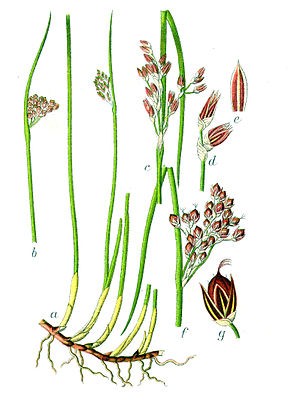Baltic bulrush
| Baltic bulrush | ||||||||||||
|---|---|---|---|---|---|---|---|---|---|---|---|---|

Baltic bulrush ( Juncus balticus ), illustration |
||||||||||||
| Systematics | ||||||||||||
|
||||||||||||
| Scientific name | ||||||||||||
| Juncus balticus | ||||||||||||
| Willd. |
The Baltic rush ( Juncus balticus Willd .; Syn .: Juncus arcticus subsp. Balticus (Willd.) Hyl. ) Is a plant from the family of the rush family (Juncaceae) that grows on beaches .
features
The Baltic rush is a perennial , herbaceous plant . It reaches heights of growth of 25 to 75 cm. It has a widely creeping, weakly branched rhizome with internodes over 1 cm long . It formed loose lawns and is blue-green.
The stems are clearly spaced from each other in a row, are rigidly upright, smooth and shiny. The marrow is broken. At the base of the stems there are straw-colored to light brown, spiderless leaf sheaths .
The inflorescence appears to be on the side in the upper third of the stem. It is loosely spirited and floriferous with 25 to 60, rarely up to 80 flowers and with 4 to 8 cm long branches. The lower bract is a continuation of the stem, is a fifth to a third as long as the stem and towers above the spirre . It's rigid and pointed. The flowers have two broad, ovate, blunt, small prophylls at the base. The tepals are 3.2 to 4.7 mm long, red to chestnut brown with a green central stripe and a white skin edge. The outer tepals are finely pointed and slightly longer than the inner ones. These are just pointy. The six stamens are up to half as long as the tepals. The anthers are 0.8 to 1.5 mm long and 1.5 to 2 times as long as the stamens. The stylus is 0.8 to 1 mm long, the scars are 1.5 to 2 mm long and erect. Flowering time is June to August, pollination takes place by the wind ( anemophilia ).
The capsule fruit is 3 to 4.5 mm long, the same length or slightly longer than the tepals. It is triangular-egg-shaped, blunt with a short, attached spike tip. The surface is light brown and shiny. The seeds are 0.8 to 1 mm long, narrowly ovoid and have two very small appendages.
The number of chromosomes is 2n = 80.
Occurrence
The distribution area of the Baltic rush is Europe, North, Central and South America. The Baltic bulrush is common on the Baltic Sea coast, but rarely occurs on Borkum on the West Frisian Islands . It grows on salt meadows and in dune valleys on peaty sandy soil. It is salt bearing.
In terms of plant sociology , it is an association characteristic of Junco baltici- Schoenetum nigricantis ( Caricion davallianae ) and is also found in Ericion tetralicis .
Systematics
One can distinguish the following seven subspecies:
- Juncus balticus subsp. andicola (Hook.) Snogerup : It occurs from Mexico to Guatemala and in western and southern South America.
- Juncus balticus subsp. ater (Rydb.) Snogerup : It occurs from North America to Guatemala.
- Juncus balticus subsp. balticus : It occurs in Northern Europe.
- Juncus balticus subsp. cantabricus (TEDíaz, Fern.-Carv. & Fern.Prieto) Snogerup : It occurs in Spain.
- Juncus balticus subsp. littoralis (Engelm.) Snogerup : It occurs in Canada and in the northern United States.
- Juncus balticus subsp. mexicanus (Willd. ex Schult. & Schult.f.) Snogerup : It occurs from the United States to Central America and from Peru to southern South America.
- Juncus balticus subsp. pyrenaeus (Timb.-Lagr. & Jeanb.) P. Fourn. : It occurs from the Pyrenees to the Sierra de Gúdar in Spain.
supporting documents
- Siegmund Seybold (Ed.): Schmeil-Fitschen interactive (CD-Rom), Quelle & Meyer, Wiebelsheim 2001/2002, ISBN 3-494-01327-6
Individual evidence
- ^ Erich Oberdorfer : Plant-sociological excursion flora for Germany and neighboring areas . With the collaboration of Angelika Schwabe and Theo Müller. 8th, heavily revised and expanded edition. Eugen Ulmer, Stuttgart (Hohenheim) 2001, ISBN 3-8001-3131-5 , pp. 149 .
- ↑ a b c d e f g h i Rafaël Govaerts (ed.): Juncus balticus. In: World Checklist of Selected Plant Families (WCSP) - The Board of Trustees of the Royal Botanic Gardens, Kew . Retrieved October 8, 2016.
Web links
- Baltic bulrush. In: FloraWeb.de.
- Baltic bulrush . In: BiolFlor, the database of biological-ecological characteristics of the flora of Germany.
- Profile and distribution map for Bavaria . In: Botanical Information Hub of Bavaria .
- The distribution of Juncus balticus as Juncus arcticus subsp. balticus in the northern hemisphere according to Eric Hultén
- Thomas Meyer: Data sheet with identification key and photos at Flora-de: Flora von Deutschland (old name of the website: Flowers in Swabia )